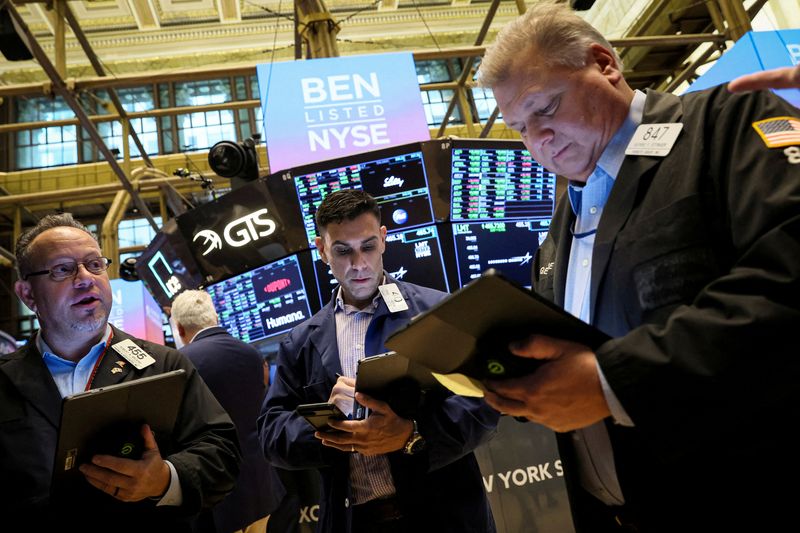Commodities
Fed turns screw, Micron pops


© Reuters. FILE PHOTO: Traders work on the floor of the New York Stock Exchange (NYSE) in New York City, U.S., November 15, 2022. REUTERS/Brendan McDermid/File Photo
A look at the day ahead in U.S. and global markets from Mike Dolan
Emboldened by still-punchy U.S. economic activity, the Federal Reserve is gradually gaining market traction with a campaign to flag two more interest rate rises this year – bolstering the dollar, particularly in Asia.
And after a mixed week for chip stocks, Micron (NASDAQ:) spun positive overnight – with its stock up 4% ahead of Thursday’s open after an earnings update infused with optimism about the artificial intelligence boom.
But as investors hit the half-year mark tomorrow, the tightening credit environment tempered fresh risk-taking.
Fed Chair Jerome Powell’s relative hawkishness, in a series of comments made in Europe over the past 24 hours, has shunted money market rates higher – with futures now starting to price a one-in-five chance of a second quarter-point rate rise by year-end. Hopes for any rate cut in 2023 are all but gone.
“I wouldn’t take…moving at consecutive meetings off the table at all,” he said, noting “the committee clearly believes that there’s more work to do, that there are more rate hikes that are likely to be appropriate”.
With the big U.S. banks passing their latest series of stress tests overnight – despite big paper bond hits over the past year and regional bank ructions in the Spring – Powell said on Thursday the Fed was ‘very reluctant’ to sound the all clear for banks just yet and further rate rises from here would be at a ‘moderate’ pace.
Two-year Treasury yields crept higher to 4.77% on Thursday after all the news, with the dollar firmer too and futures marginally positive – helped by Micron. The volatility gauge remains subdued at 13.6.
Powell’s relative hawkishness was mostly matched by counterparts at the European Central Bank and Bank of England yesterday. Sweden’s Riksbank was the latest to push ahead with a rate hike on Thursday, and German inflation readouts for June pointed to a worrying re-acceleration of price rises there.
But Western central banks’ doubling down on rate rise plans stands in stark contrast to super-easy stances in Japan and China – with commensurate pressure building on the yen and the yuan against a resurgent dollar as a result, despite local efforts to frustrate dollar moves to 2023 highs this week.
Dollar/yen hit another 7-month high on Thursday.
Elsewhere, fashion retailer H&M jumped 11% to a 16-month high after its second-quarter profit beat forecasts.
And food companies will closely eye news that one of the most common artificial sweeteners is set to be declared a possible carcinogen next month by a leading global health body.
Events to watch for later on Thursday:
* U.S. final Q1 GDP and related inflation estimates, weekly jobless claims, May pending home sales
* Federal Reserve Chair Jerome Powell speaks in Madrid, Atlanta Fed President Raphael Bostic speaks in Dublin
* European Union summit in Brussels
* U.S. corporate earnings: Nike (NYSE:), McCormick (NYSE:), Paychex (NASDAQ:)
(By Mike Dolan, editing by Elaine Hardcastle mike.dolan@thomsonreuters.com. Twitter: US consumer confidence https://tmsnrt.rs/3PybBqt@reutersMikeD)
Commodities
Oil prices rise; U.S. crude inventories plunge, Russia-Ukraine truce eyed
Commodities
India’s Reliance to stop buying Venezuelan oil over US tariffs, sources say
Commodities
Oil prices climb on Venezuela supply worries

 Forex3 years ago
Forex3 years agoForex Today: the dollar is gaining strength amid gloomy sentiment at the start of the Fed’s week

 Forex3 years ago
Forex3 years agoUnbiased review of Pocket Option broker

 Forex3 years ago
Forex3 years agoDollar to pound sterling exchange rate today: Pound plummeted to its lowest since 1985

 Forex3 years ago
Forex3 years agoHow is the Australian dollar doing today?

 Cryptocurrency3 years ago
Cryptocurrency3 years agoWhat happened in the crypto market – current events today

 World3 years ago
World3 years agoWhy are modern video games an art form?

 Commodities3 years ago
Commodities3 years agoCopper continues to fall in price on expectations of lower demand in China

 Economy3 years ago
Economy3 years agoCrude oil tankers double in price due to EU anti-Russian sanctions



























